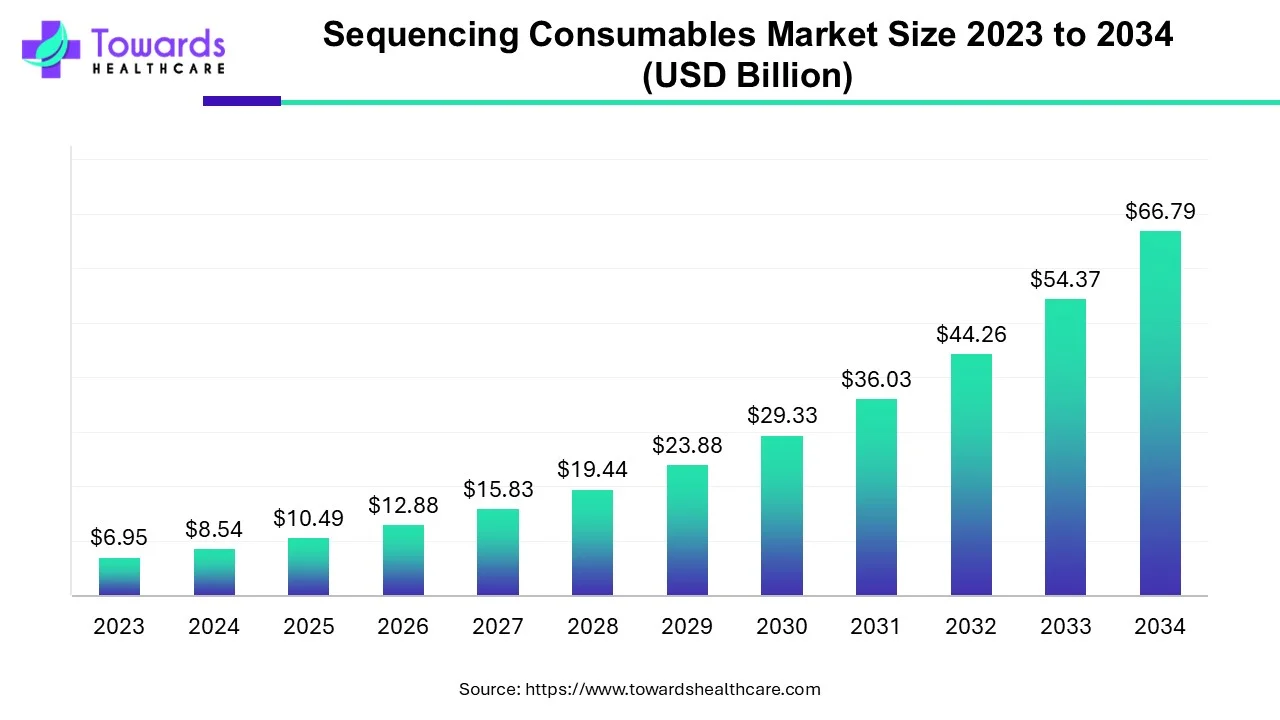The sequencing consumables market is experiencing rapid growth, driven by advancements in genetic sequencing technologies and the increasing demand for applications in personalized medicine, disease diagnostics, and other critical research areas. The global market, valued at approximately US$ 8.54 billion in 2024, is expected to grow to US$ 10.49 billion by 2025, with a projected market size of around US$ 66.79 billion by 2034. This growth represents a compound annual growth rate (CAGR) of 22.84% from 2024 to 2034, reflecting the expanding role of sequencing technologies in various industries.

Get All the Details in Our Solution – Download Brochure @ https://www.towardshealthcare.com/download-brochure/5350
Kits: Dominating the Sequencing Consumables Market
By product, the kits segment has remained the largest shareholder of the sequencing consumables market in 2023 and continues to dominate the market. Sequencing kits are essential because they provide all the necessary components—such as reagents, enzymes, and buffers—in one package, streamlining the sequencing process and reducing the risk of errors. The convenience of having these components in a single kit not only enhances the accuracy of genetic sequencing but also improves overall efficiency, making them highly preferred by researchers and institutions.
Reagents: The Fastest Growing Segment
While kits lead the market, the reagents segment is poised for the fastest growth during the forecast period. Reagents, which include individual enzymes and chemicals, offer greater flexibility in sequencing procedures, allowing researchers to customize their approaches and select specific components for their work. This flexibility makes reagents particularly attractive for large-scale research projects or when specific reagents are required in higher quantities. The increasing demand for reagent-based solutions is a key trend shaping the sequencing consumables market in the coming years.
Second-Generation Sequencing: The Current Leader
Second-generation sequencing (2ndGS) platforms hold the largest share in the sequencing consumables market by platform. These technologies remain the most widely adopted due to their cost-effectiveness and high throughput capabilities. They enable the generation of large volumes of data in a short period, which is essential for a variety of applications such as whole genome sequencing, target resequencing, and transcriptome sequencing. The continued prevalence of 2ndGS technologies in both clinical and research settings is expected to drive the market forward, with increasing usage across fields like oncology, genetics, and genomics.
Third-Generation Sequencing: Fast-Growing and Innovative
Third-generation sequencing (TGS) consumables are anticipated to grow at the fastest rate over the forecast period. TGS technologies, including single-molecule and real-time sequencing, are pushing the boundaries of genetic research by enabling deeper insights into genomic structures. TGS allows for more detailed and comprehensive studies of genomes, transcriptomes, and metagenomes, providing unprecedented capabilities in genetic disease research. As TGS continues to evolve, it holds tremendous potential to uncover new genetic information, thus attracting more investments and driving market growth.
Cancer Diagnostics: Dominating Applications
In terms of applications, cancer diagnostics remains the largest segment of the sequencing consumables market. With millions of people affected by cancer globally, the demand for precise, genetic-based diagnostics is growing. The ability to sequence cancer genomes enables personalized cancer therapies, where treatment plans are tailored based on the genetic characteristics of the tumor. This personalized approach has proven to be far more effective than traditional methods, driving the ongoing adoption of sequencing technologies in oncology. By 2030, the sequencing of millions of cancer patient genomes is expected to be a standard practice, further advancing the market’s growth.
Pharmacogenomics: Lucrative Growth Prospects
The pharmacogenomics segment is another area poised for substantial growth. Pharmacogenomics, which focuses on tailoring drug prescriptions to an individual’s genetic makeup, is becoming an increasingly important area in healthcare. Sequencing technologies are central to this field, allowing for the identification of genetic variations that affect drug responses. As more healthcare providers adopt pharmacogenomic practices, the demand for sequencing consumables to guide medication prescriptions is expected to rise significantly in the coming years.
Hospitals & Laboratories: The Leading End-Use Sector
By end-use, hospitals and laboratories held the largest share of the sequencing consumables market in 2023. The rise of personalized medicine, which uses genetic sequencing to design customized therapies, is one of the major factors fueling growth in this segment. In clinical settings, sequencing has demonstrated its ability to offer more precise diagnoses and better treatment options, especially in oncology. As sequencing technologies continue to gain acceptance in clinical treatment, hospitals and laboratories will remain the key consumers of sequencing consumables.
Pharmaceutical & Biotechnology Companies: Fastest-Growing End-Use Sector
The pharmaceutical and biotechnology companies segment is expected to see the fastest growth in the sequencing consumables market. Pharmaceutical and biotech firms are increasingly utilizing next-generation sequencing (NGS) for various purposes, including identifying genetic mutations, understanding disease mechanisms, and developing targeted therapies. As NGS technology helps these companies gain deeper insights into genetic disorders and disease pathways, the demand for sequencing consumables in drug discovery and development is set to rise sharply.
Market Trends and Future Outlook
The sequencing consumables market is evolving rapidly, with several key trends influencing its growth trajectory. The increased focus on precision medicine, the growing demand for cancer diagnostics, and the continued adoption of next-generation sequencing technologies are all driving demand for sequencing consumables. Companies in the market are investing in research and development to improve the efficiency, accuracy, and accessibility of sequencing technologies. Innovations in third-generation sequencing and the continued refinement of reagent-based solutions are expected to further accelerate the growth of the market.
Our Table of Content (TOC) covers key healthcare market segments, materials, technologies and trends—helping you navigate market shifts and make informed decisions: https://www.towardshealthcare.com/table-of-content/sequencing-consumables-market-sizing
Invest in Our Premium Strategic Solution @ https://www.towardshealthcare.com/price/5350
We’ve prepared a service to support you. Please feel free to contact us at sales@towardshealthcare.com
Web: https://www.towardshealthcare.com
Visit Dental Specifics: https://www.towardsdental.com
Get the latest insights on industry segmentation with our Annual Membership: Get a Subscription
For Latest Update Follow Us: https://www.linkedin.com/company/towards-healthcare



